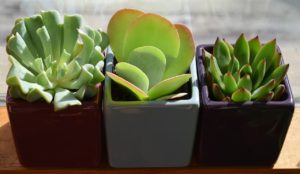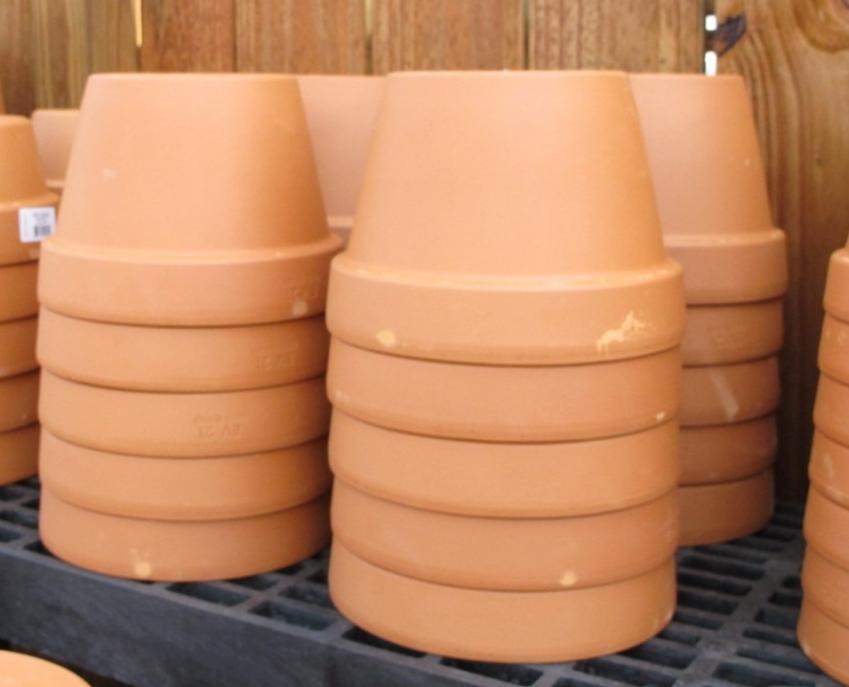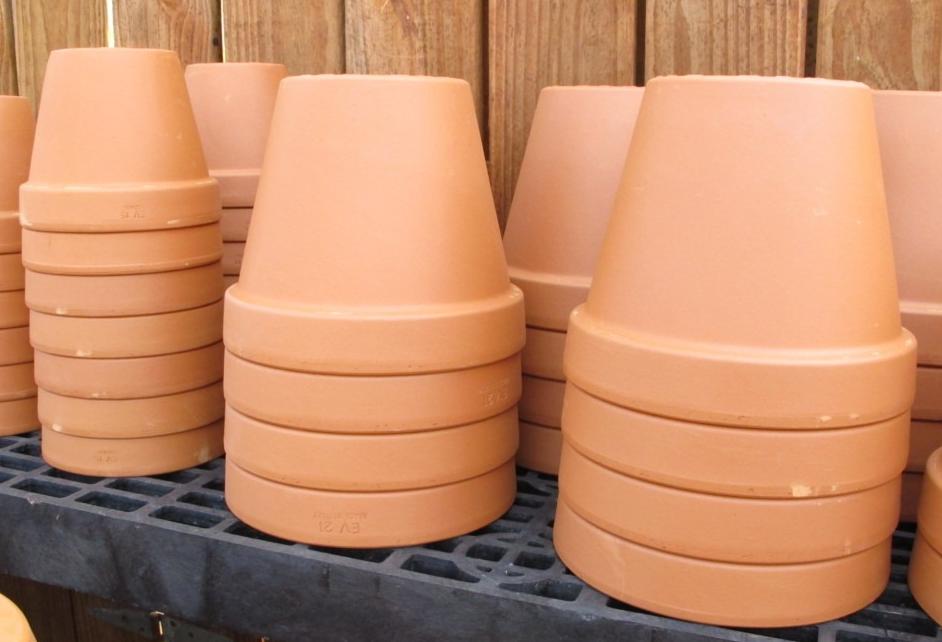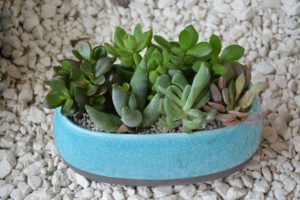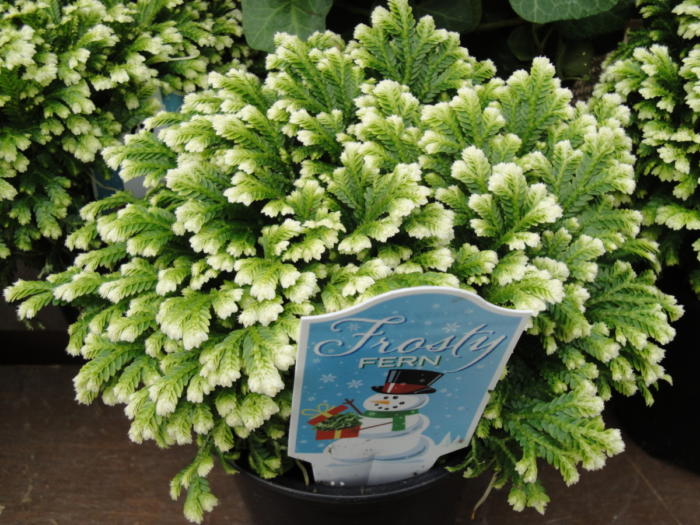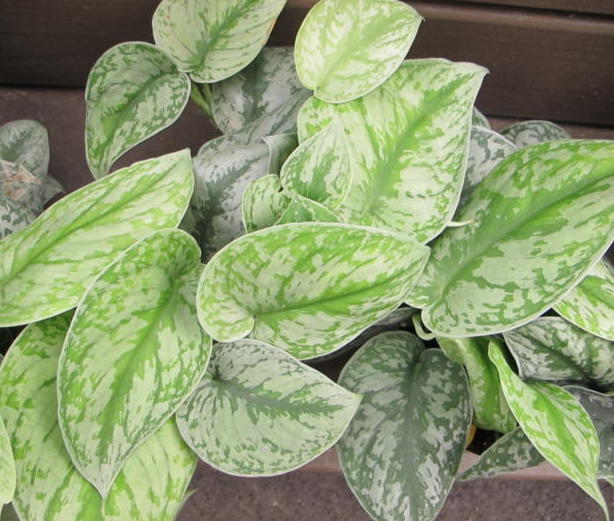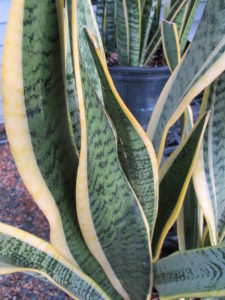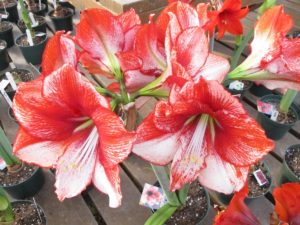Page 3
Succulents
Sun-loving succulents must have at least a few hours per day of direct sunshine, not just indirect light. And they do best in “tight” pots, kept potbound; the roots are bound, or limited, by the size of the pot. A 5″ or 6″ clay azalea pot is appropriate for a well-branched 14″ tall jade plant (Crassula). Next spring might be a good time to repot the jade plant into a pot that’s only 1″ or 2″ larger if it needs it. Several succulents in our sunny windows have been growing in 1½” to 2″ pots for several years.
For now, in the winter, keep your succulents potbound…very potbound! Spring and early summer are the preferred seasons for repotting most plants. This gives them months to develop a full root system before cool weather and shorter days return in autumn. Most houseplants do not actively grow in the winter and are best left undisturbed.
An overpotted jade plant or other succulent probably has parts of the soil in which there are few or no roots. When the plant is watered, a large amount of moisture is stored in that “unoccupied” soil. Since it takes a long time for water to evaporate or to get used by the plant, it’s more likely to cause root rot.
That’s why it’s important to keep succulents in tight pots and to water only when the weather forecast calls for a few days of sunny skies. Direct sunlight stimulates activity (photosynthesis, respiration, transpiration), causing the plant to use the water at a faster rate. But the rate of growth in winter generally is slower than in the longer days of the growing season, spring through early fall.
- Azalea pots, height = 3/4 width.
- Standard pots, height = width.
Porous Pots
Terra cotta, or clay, pots allow water vapor to pass through the walls of the pot. Clay absorbs moisture from the soil, hastening the drying process. And it allows air to reach the soil as well.
Highly porous clay readily absorbs water and will immediately turn dark when water is dripped onto it. Some manufacturers of clay pots, however, fire them at higher temperatures, making them less porous to air and water. Plants that need to dry out faster survive longer in porous terra cotta than in non-porous clay, ceramic, or plastic.
For most purposes, I prefer the proportions of “azalea” pots, (height of the pot is 3/4 the diameter), which are shorter than “standard” pots (height equals diameter; photo, above).
Succulents grown together in a shallow glazed container (photo, above), such as a bonsai tray, make an attractive display. Shallow pots hold less soil. But if gravel is used as a mulch, feel the soil, instead of guessing, to determine whether or not water is needed. Or stick a wooden skewer to the bottom of the pot, wait 15 minutes, then remove to check how moist it is.
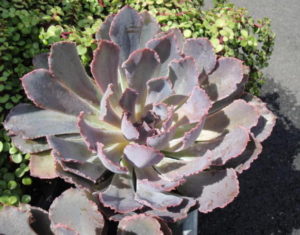
A healthy Echeveria.
Succulents, such as living stones, cacti, and Echeveria, need strong direct sunlight for 6 hours or more each day. Lower light levels, oversized pots, and too much soil moisture can result in a collapsed mass of soggy foliage. This also can happen when water sits on the leaves. These plants are dead and will not recover.
Jade plants with constantly moist soil and less than ideal growing conditions might drop leaves. Side branches also can fall off. Many feel sorry for the plant, and give it even more water, but that will make the problem worse. In this case, act quickly to save the plant by…
…Repotting and Refreshing
Remove the wet plant from the pot. Hold it upside-down, with stem between fingers, and tap the top edge of the pot onto the edge of a table. Make sure roots protruding from the drainage holes aren’t preventing movement of the root ball. If needed, use a thin-bladed knife to separate the root ball from the inside of the pot. Hold it upside-down and try again.
Now that the root system is visible, remove soil that has no roots. It’s probably heavy, wet, and maybe smelly. Toss it into the garden, but don’t reuse it for your houseplants. There are hardly any roots on a plant in an advanced state of rot. If you see some white or light tan roots, there’s hope. But if the stem has withered and the bark “slips”, it’s time for a new plant.
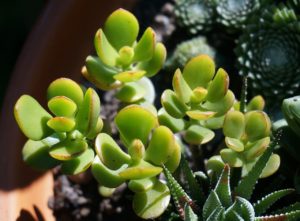
Jade plant.
If the jade plant or shrubby types of succulents seem top-heavy, cut back the plants. Dormant buds will sprout from the stems if the plant has enough energy to regrow. Healthy stem tips can be potted up into small clay pots, and will grow roots if the conditions are right.
Wrap the roots with paper towels and squeeze gently to absorb excess water.
Now, pot up the plant, not burying the stem any deeper than it was growing before. Use fresh, dry cactus/succulent soil firmed around the root system. If using regular potting soil, add drainage material, such as coarse sand, PermaTill, perlite, or grit of some sort. These are materials that do not hold water. Use a 1:1 or 2:1 ratio of potting soil:drainage material. Cacti need more grit than they need water-holding media.
Pot Size
And be sure to use a small pot, just big enough to fit the roots. So, if the living root system is only 3″ wide and deep, use a 3″, or maybe 4″, clay pot. Start small! Using pots that are too large will not encourage plants to grow fast, but can hasten their death.
If needed, use bamboo stakes to prop up the stem until the root system can hold it upright. Don’t water just yet.
Maintenance
Finally, place the plant in a warm, sunny window. New roots grow faster at warmer temperatures (above 70°F), and a compromised root system can rot in cold soil. Feel the soil well below the surface to see if it’s dry enough to water. Did you check the weather forecast? Great! Sunny days ahead! It’s better to delay watering if cloudy weather is going to hang around for a couple of days.
Water thoroughly when the soil has dried completely. Don’t give a tiny bit of water frequently; roots on the bottom of the pot might not get enough water. Instead, moisten the entire root ball of a well-rooted plant, and then let it dry out. Never let succulents sit in a saucer of water for more than a few minutes.
If in doubt, though, give the jade plant less water. Or, you could knock the plant out of the pot to check the soil’s moisture level. Abundant sunlight each day will keep the plant strong and help dry the soil.
Ferns
- ‘Frosty’ fern (Selaginella sp.), a fern ally.
- The crocodile fern (Microsorium musifolium ‘Crocydyllus’).
And now, the ferns. Their soil should stay moist at all times. Maidenhair (Adiantum species), brake ferns (Pteris species), and the related Selaginella mosses wilt in a flash if the soil dries out. When these plants run too dry, tender new fronds wilt first and then margins or whole fronds will turn brown.
Boston ferns (Nephrolepis species) will drop hundreds of little pieces, the pinnae, if those fronds went dry. Cut off at the soil surface any fronds that have yellowed or that have dropped their pinnae.
If all the foliage stays wilted after watering, and none of it takes up water, cut back the entire plant at the soil line. Water held in the rhizomes (underground stems) or in the crown of the plant might be sufficient for new growth to emerge. Water often enough to keep the soil moist. If new growth fails to appear within 2 or 3 weeks, the plant won’t come back to life.
Most ferns grow well in bright indirect light or morning sunshine. In very low light levels, not enough energy is absorbed to support new growth. With decent humidity, even the delicate maidenhairs can take some gentle direct sun. This makes the tissues slightly thicker and better able to withstand dry air.
Raise the Humidity
An easy method of raising humidity around your houseplants is to cluster them together near a bright window. Each one gives off humidity from the leaves and from the soil, benefiting all.
Ferns on pebble trays prosper in the normally dry air indoors. Those are large saucers filled with pebbles or gravel, and contain water kept at a level below the bottom of the pots. The water evaporates, raising the humidity near the plants. Periodically refill with water.
Lowering the temperature in your living space raises relative humidity. And setting the thermostat a few degrees lower at night also raises the relative humidity. Ferns prefer temperatures in the high 50’s to low 60’s. With high humidity, such as in a Wardian case or a terrarium, they will do well with higher temperatures, but don’t let direct sunshine hit a closed (unvented) terrarium for any length of time, or the plants will perish.
Pothos and Philodendron

Four kinds of pothos, clockwise from top left: Golden pothos, ‘Marble Queen’, ‘Pearls and Jade’, and silver.
Pothos (Epipremnum) and Philodendrons are understory tropical forest vines. They thrive in dappled sunlight and warm temperatures as they scamper over the ground. These plants are able to climb tree bark by clinging with aerial roots that emerge along their stems. They must do this in order to mature to their adult phase, when they flower and reproduce.
Silver, golden, and ‘Marble Queen’ pothos, and heartleaf philodendron (P. cordatum) grow best in potbound conditions, and at moderate to warm temperatures (68° to 75°F). If the floor is too cold, raise the plant up onto a table. Windows that are warm in the daytime might be too chilly for them at night.
Some direct sunlight in the winter keeps the plants strong, produces better color, and helps dry the soil faster. If you don’t have sunny windows, give them the brightest indirect light available. Supplemental light from a table lamp can help, as long as the plant can’t feel the heat. CFL’s and LED’s use less energy than incandescents and are much cooler.
Large soil volumes in oversized pots hold more water than these plants can use, and often end up rotting the roots. Root rots are caused by fungal infections, primarily Phytophthora, brought on by adverse conditions, such as cold, wet soil. Older leaves begin to turn yellow. Philodendron and pothos are sold with several rooted stems per pot. The stems die off in wet soil, one by one, with leaves curling and stems turning black or spotted. So, keep these plants potbound.
You might be able to salvage an ailing plant. Remove the plant from the pot, and discard rotten roots, soggy soil, and wilted stems. Repot the healthy sections into a smaller pot, just big enough to fit the root system. Use barely damp or dryish potting soil that has peat moss in it, and pine fines or perlite for drainage. Soil with good drainage allows more air to circulate through it.
Overwatering is death to these plants. Water when the soil feels dry about an inch down from the soil surface, and use lukewarm water. Never let the pot sit in water. Plants suffer when soil stays too moist and air circulation in the medium is cut off.
- Windowpane philodendron, Monstera obliqua ‘Leichtlinii’.
- Silver pothos, Scindapsus pictus.
When I lived in Maryland, I kept a ‘Marble Queen’ pothos in a 6″ pot inside a basket for many years. The pothos didn’t receive much natural light, and the table lamp (with a 12 watt compact fluorescent lightbulb) above it was its primary source of light. The more hours the lamp was on, the more white variegation showed up in the foliage.
I fertilized this plant every 6 to 8 weeks, and cut back long stems to within 1″ or 2″ of the soil to control the growth. New stems emerged from the stumps, filling out the pot and keeping the basket full of foliage. And, naturally, all the cuttings were rooted (one leaf per cutting, 6 or 7 cuttings per 4″ pot) under lights in the basement, and later sold at farmers’ markets.
Snake Plant
Snake plants (formerly Sansevieria trifasciata, now Dracaena trifasciata, and other species) are durable semi-succulents. They can tolerate lower light levels for a period of time, although the best-looking foliage grows with bright light or a few hours of direct sunlight.
The same goes for most plants: winter sun is weak, and most plants thrive with at least some direct sunlight during those months of the year. Leaf variegation is more pronounced in stronger light. Because each leaf can live for several years, scratches and scars linger as well, so handle carefully.
Allow the soil to dry almost completely before watering again. If the swordlike leaves turn soggy and collapse, they are rotting, most likely from too much water. Other causes could be water sitting at the base of the leaves or a fungal infection that snake plants sometimes get.
One way to avoid this is by keeping it potbound. Soil that is filled with healthy roots will not be able to store much excess water, so there will be fewer problems with root rot. And apply water to the soil surface, not on the foliage. Mature potbound plants sometimes flower, filling the night air with a strong fragrance.

A light green variety of snake plant at Pike Nurseries.
These are tough plants and often recommended for beginning gardeners. There are 6′ tall giant species, and there are dwarf types (D. hahnii) that stay under 6″ tall for a decade. Leaves can be solid ghostly green, banded in several shades of green, variegated with bright white stripes (‘Bantel’s Sensation’), and round in cross-section (D. cylindrica).
The yellow-margined Dracaena trifasciata ‘Laurentii’ must be propagated by division; plants propagated from leaf cuttings lose the yellow margin.
What is CAM?
One curious thing about snake plants and many other succulents is the fact that this group of plants gives off oxygen during the night instead of in the daytime like most plants. These are called “CAM” plants, utilizing crassulacean acid metabolism.
In order to conserve moisture in their hot, sunny native environments, they evolved so their stomates open at night and close during the daytime. Stomates are pores on the leaf surface that open or close, regulating gas exchange between the atmosphere and the leaves’ interiors.
The carbon dioxide gathered is converted to malic acid and stored in the leaf vacuoles. During photosynthesis, in the daytime, that material is converted back to CO2 and used to make sugars.
English Ivy
English ivy (Hedera helix) is an invasive woody vine, and can grow to huge proportions, rooting as it travels along the ground, up a tree, or over buildings. Grown in a pot, it behaves and can be used in a number of ways. But I never recommend it as a ground cover outdoors. In the winter, indoor ivy likes some direct sun or at least very bright indirect light.
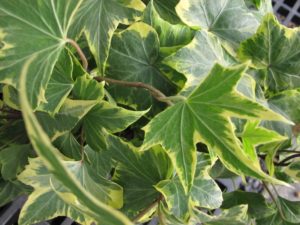
English ivy with deeply incised variegated leaves.
Ivy is grown in starter pots 2″ in diameter to specimens in 10″ pots. There are miniatures, such as ‘Duckfoot’ and ‘Spetchley’, with tiny leaves barely 1/2″ long. Varieties with rich green leaves (‘Shamrock’) or variegated in white or yellow (‘Kolibri’, ‘Glacier’, ‘Gold Child’) are readily available.
It grows in hanging baskets, combination planters, and as topiary. Topiary is the art of clipping and training plants to grow in geometric forms or shapes that resemble animals or people. The foliage grows thickly, disguising the wire frame that serves as the support system. Interior or shaded leaves of potted ivy topiaries turn yellow if they don’t receive enough light. Yellow leaves are highly visible, so remove them if they appear.
This is another plant that can live for a long time in a pot as small as 4″ wide. Larger specimens and 5′ tall topiaries are happy residing in 6″, 8″, or 10″ pots for many years. A common theme here is that most houseplants decline in soil that stays wet. Ivy is no exception. Overpotting and overwatering damage the roots, causing stems to die off one at a time.
During transpiration, water evaporates from the leaves to the atmosphere. It is replaced with water drawn up from the roots through the part of the vascular system called xylem. Ivy is grown with about 6 to 12 stems per 6″ pot. If the stems begin to die, there is less foliage from which water can evaporate, causing more water to linger in the soil. Ivy is another plant that is susceptible to fungal root rot diseases caused by Phytophthora. The more stems that die off, the harder it is to keep the others alive.
Spider Mites
Because topiaries are three-dimensional, they need to be turned every few days to expose the plant to light on all sides. All plants should be turned now and then for that reason. But keep ivy cool (50° to the low 60’s) or you’ll have another problem on your hands. Warm temperatures and dry indoor air are the perfect ingredients for a spider mite infestation. Mites reproduce very fast under these conditions, building up large populations within a short period of time.
Where did they come from? There are a few species of spider mites, and they can float on the air if it’s above freezing. They hitchhike on our clothing and on the tools we use. They can crawl from one plant to the next. Weather conditions (breeze, rain, cool temperatures), beneficial insects, and predatory mites keep their numbers in check.
Spider mites themselves are barely visible. But if you shake or tap a stem with a suspected infestation over a sheet of white paper, you might see tiny specks crawling about. The damage they cause is noticeable. As the mites suck plant fluids out of cells, those cells die, leaving light-colored stippling on the surface of the leaf. Those spots will not green up again.
An infestation of two-spotted spider mites is under way on this Alocasia (photo, above). There’s fine dusty debris and some stippling on the surface of the leaf. (Hail caused the larger hole in the leaf.) I used a wet sponge to wipe away the mites, and will mist the plants in that area every few days for a while.
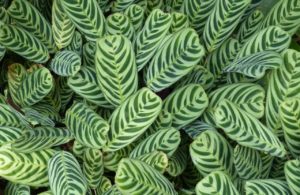
Calathea, related to the prayer plant.
Reproducing females spin very fine webs over the surfaces of leaves and stems. Ivy, schefflera, ming aralias (these 3 are in the Araliaceae family), prayer plants (Maranta species), calathea, croton, palms, Alocasia, and ficus are especially attractive to spider mites.
This sounds rather dire, but there are some simple steps you can take to prevent or treat an infestation.
Try These Tips:
- Keep ivy cool. This slows down but does not stop mite reproduction.
- When ivy is due to be watered, take it to the kitchen sink or to the shower (large plants), and spray cool water all over the foliage, tops and bottoms of leaves. Use a strong spray to dislodge mites and eggs from hidden crevices. You don’t have to do this every time. Good news: mites drown easily. Yay!
- Consider keeping the plants outdoors in spring, summer, and early fall if mites are a problem indoors. Place them in bright indirect light or dappled sunlight, and give them a good hosing down now and then. Most varieties of English ivy tolerate frost as long as they’re acclimated to dropping temperatures.
- Mist foliage in the morning or early afternoon, heavily, top surfaces and undersides. If you do this periodically, or when first noticing an infestation, spider mite populations will not build up to unmanageable proportions. As water evaporates, though, a small amount of calcium and other minerals can leave a white residue on the foliage. Wiping the leaves with a solution of horticultural oil on a soft cloth removes most of the residue.
- Spray a solution of horticultural oil all over the plant and the pot. Oil suffocates insects and mites and also kills the eggs. (Insecticidal soap kills insects and mites, but not their eggs.) Pests cannot develop resistance to horticultural oil. Oil nicely cleans the foliage, dissolving residues and giving leaves some luster. Don’t use a very concentrated solution; this could cause oil-soaked areas on the leaves that might not recover. Careful; it causes slippery surfaces. Read the label.
- Systemic insecticides will keep ornamental plants (never use on edibles) free of insects and mites for at least a few weeks. Most systemic insecticides kill mites, even though they’re not insects (they’re arachnids). Some have an odor which can linger. Ask your local garden center experts. Horticultural oil and systemic insecticides also effectively eradicate other insects, such as scale, aphids, and mealybugs. Always read the label.
Will They Flower Some More?
Many of the plants we use during the holidays flower for a few weeks, or in the case of poinsettias and cyclamen, for a few months.
Paperwhite narcissus (N. papyraceus) can be planted outdoors after the coldest part of winter has passed. They’re hardy in Zones 8 through 10 or 11. Each bulb has between 1 and 3 very fragrant flower stems. But when it’s done, it’s done. Most people simply discard the plant. If you live in the warmer parts of the country, you can add them to your spring-flowering bulb gardens when the harsh winter temperatures have passed.
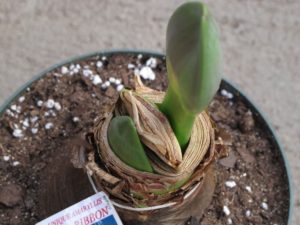
This large Amaryllis bulb has 2 flower buds. More flowers could emerge later.
Large amaryllis bulbs produce a few gorgeous flower stems, with 4 to 6 (rarely 8) florets in each inflorescence. Cut the withered flower stalk down to the bulb. Keep the plants indoors during the cold winter months, even after they finish blooming. When warm weather returns in spring, move the amaryllis plants outdoors. There, in brighter sunlight, they’ll prepare for next year’s flowering season.
Warm soil temperatures contribute to a well-rooted amaryllis. However, once the pot fills with roots, lowering the temperature will preserve the flowers a few more days.
Before You Know It
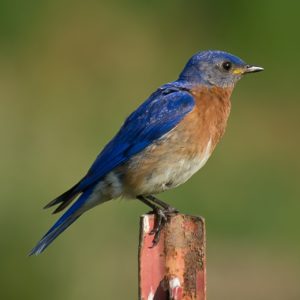
An eastern bluebird.
The busy and colorful Christmas season is over. We can fuss with the houseplants, peruse seed catalogs, enjoy greens from the garden…and anticipate the first amaryllis flower. They just started growing!
One season seamlessly proceeds to the next. For many years, we have enjoyed feeding the birds outdoors. Chickadees, brown-headed nuthatches, tufted titmice, towhees, gold and house finches, cardinals, bluebirds, brown thrashers… Downy and red-bellied woodpeckers, sparrows, and the occasional bluejays and starlings, and in the winter, slate-colored juncos. And, of course, our constant companions, the Carolina wrens.
Recently, wrens and some of the other songbirds have “changed their tunes”, a prelude to the nest-building activities that will occupy their time in the coming months.
Seamless, but not unnoticed, as the birds remind us.
Headings:
Page 1: What Is Wrong With My Houseplants?, My Peace Lily Is Wilting, How Often Should I Water My Peace Lily? (The Environmental Variables, How Can I Tell When To Water?, Upon Careful Examination)
Page 2: How Often Should I Water Houseplants?, Should I Fertilize My Houseplants?, Brown Tips On Houseplants (Overwatering, Underwatering, Overfertilization, Disease, Guttation, Fluorine), Yellow Leaves, and My Houseplants Are Dropping Leaves
Page 3: Succulents (Porous Pots, Repotting and Refreshing), Ferns (Raise the Humidity), Pothos and Philodendron, Snake Plant (What is CAM?), English Ivy (Spider Mites), Will They Flower Some More?, and Before You Know It
